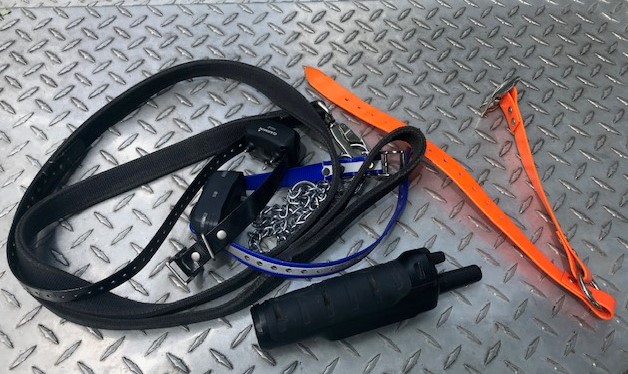
Knowing Dog Training Equipment Options
There are as many different tools for dog training as there are breeds of dog. The secret to dog training success is knowing when to use each tool for various training scenarios. Listed here are a variety of dog training equipment options.
Collars
Dog collars are the most diverse training equipment option. There are numerous types of collars, each with a different function.
Flat Collar
A flat collar, either with a buckle or quick-release snap, is a great tool for starting your dog’s training from a young age. This type of collar is for every-day use and is helpful for laying a basic training foundation. Flat collars can also be purchased in a breakaway style that releases under pressure should it become caught on an object, such as a fence. This mechanism is inactive, however, when a leash is attached.
Slip Collar
A slip collar is also called a choke chain or choker and is made of nylon or chain. This type of collar provides correction to the dog when the leash portion is sharply pulled, thereby squeezing the neck and momentarily restricting the dog’s breathing.
Limited Slip Collar
A limited slip collar (also known as a martingale or greyhound collar) is limited in the amount of pressure that can be applied to the dog’s trachea. Commonly, this type of collar is used on dogs who are prone to backing out of their collars, as the self-tightening mechanism prevents escape. Dogs whose necks are the same diameter or larger than their heads, such as greyhounds, typically wear this style of collar.
Head Halter
A head halter wraps around the dog’s face in a similar fashion to a horse halter in to apply pressure to the bridge of the dog’s nose to discourage leash pulling.
Prong / Pinch Collar
A prong or pinch collar (sometimes also called a spike collar) has prongs that face inward, towards the dog’s neck. When pressure is applied to the collar, the prongs pinch the sensitive skin on the dog’s neck to discourage certain behaviors.
Electronic Collar
Also known as an e-collar, shock collar, or stimulation collar, an electronic dog collar has a variety of uses. This training tool administers varying levels of static stimulation to your dog in order to discourage behavior, get a dog’s attention, or promote good behaviors. Common uses for an electronic collar include in-ground fencing, as a bark collar, or for advanced training. If you have questions or are unsure of e-collar use, we suggest seeking the advice of a professional dog trainer.
Harnesses
In addition to collars, harnesses can be used as training tools, particularly for pets who are not good candidates for collars due to weak tracheas or neck injuries. In general, harnesses wrap around the dog’s chest and body and evenly distribute the animal’s weight.
Front Clip Harness
A front clip harness is used for discouraging leash pulling. The leash attaches to a ring on the dog’s chest. When the animal pulls, he or she will be forced to turn 180 degrees, thus discouraging the dog from this behavior.
No-Pull Harness
There are a variety of no-pull harnesses on the market in the style of a slip lead. The harness tightens across pressure points behind the dog’s front legs or across the chest whenever the animal pulls in order to discourage this behavior.
Leashes
Standard Leash
A standard leash is used with the majority of collars or harnesses listed here and is the most common way to control a pet. Leashes can be made from materials such as nylon, leather, or chain, in lengths from 2’ – 60’.
Retractable Leash
A retractable leash has a cord that automatically lengthens and retracts with the press of a button. These leashes can be used for training a dog from a distance, but should only be used after an animal has been trained to respect commands such as recall.
Crate
As den animals, every dog requires an isolated area for relaxation and retreat. Additionally, crates are indispensable for house training, as well as keeping your dog (and your house) safe while you are away from home.
Crates can be made from wire, plastic, wood, aluminum, or fabric. Each type of crate has a specific use, with wire crates most common and appropriate for training.
A dog’s crate should be just large enough for standing up and turning around. Too large a crate encourages a pet to eliminate in one end while sleeping in the other. Special crate considerations should be made if the item is to be used for transporting a pet or in specific circumstances.
A Note on Dog Training Equipment
When used incorrectly, every training tool on this list can be hazardous to your pet. If you are in doubt about the proper use of any piece of dog training equipment, particularly choke, prong, or electronic dog collars, consult a dog training professional.

Recent Comments